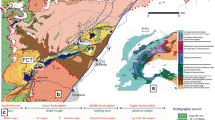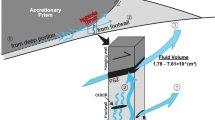Abstract
The geochemistry of carbonate fault rocks has been examined in two areas of the Arava Fault segment, which forms the major branch of the Dead Sea Transform between the Dead Sea and the Gulf of Aquaba. The role of fluids in faulting deformation in the selected fault segment is remarkably different from observations at other major fault zones. Our data suggest reduced fluid rock interactions in both areas and limited fluid flow. The fault did not act as an important fluid conduit. There are no indications that hydrothermal reactions (cementation, dissolution) did change the strength and behavior of the fault zone, although the two areas show considerable differences with respect to fluid sources and fluid flow. In one area, the investigated calcite mineralization reveals an open fluid system with fluids originating from a variety of sources. Stable isotopes (δ13C, δ18O), strontium isotopes, and trace elements indicate both infiltration of descending (meteoric and/or sea water) and ascending hydrothermal fluids. In the other area, all geochemical data indicate only local (small scale) fluid redistribution. These fluids were derived from the adjacent limestones under nearly closed-system conditions.









Similar content being viewed by others
References
Atallah MY (1992) Tectonic evolution of the northern Wadi Arava. Tectonophysics 204:17–26
Barjous M, Mikbel S (1990) Tectonic evolution of the Gulf of Aquaba Dead Sea transform fault. Tectonophysics 180:49–59
Bau M, Möller P (1992) Rare earth element fractionation in metamorphogenic hydrothermal calcite, magnesite and siderite. Mineral Petrol 45:231–246
Blanpied ML, Lockner DA, Byerlee JD (1992) An earthquake mechanism based on rapid sealing of faults. Nature 358:574–576
Burkhard M (1993) Calcite-twins, their geometry, appearance and significance as stress-strain markers and indicators of tectonic regime: A review. J Struct Geol 15:351–368
Byerlee J (1993) Model for episodic flow of high-pressure water in fault zones before earthquakes. Geology 21:303–306
Chester FM, Evans JP, Biegel RL (1993) Internal Structure and weakening mechanisms of faults of the San Andreas Fault system. J Geophys Res 98:771–786
Conti A, Turpin L, Polino R, Mattei M, Zuppi, GM (2001) The relationship between evolution of fluid chemistry and the style of brittle deformation: examples from the Northern Apennines. Tectonophysics 330:103–117
Courtillot V, Armijo R, Tapponnier P (1987) The Sinai triple junction revisited. Tectonophysics 141:181–190
DESERT Group (2004) The crustal structure of the Dead Sea Transform. Geophys J Int 156:655–681
Dulski P (1994) Interference of oxide, hydroxide, and chloride analyse species in determination of rare earth elements in geological samples by inductively coupled plasma-mass spectrometry. J Anal Chem 350:194–203
Evans JP, Chester FM (1995) fluid–rock interaction in faults of the San Andreas System: Inferences from San Gabriel fault rock geochemistry and microstructures. J Geophys Res 100:13007–13020
Ferrill DA, Morris AP, Evans MA, Burkhard M, Groshong RH Jr, Onasch CM (2004) Calcite twin morphology: a low-temperature deformation geothermometer. J Struct Geol 26: 1521–1529
Friedman I, O’Neil JR (1977) Compilation of stable isotope fractionation factors of geochemical interest. In: Fleischer M (ed) Data on Geochemistry. U.S. Geological survey Professional Paper 440-kk:1–12
Galli P (1999) Active tectonics along the Wadi Araba-Jordan Valley. J Geophys Res 104:2777–2796
Garfunkel Z (1981) Internal structure of the Dead Sea leaky transform (rift) in relation to plate kinematics. Tectonophysics 80:81–108
Garfunkel Z, Zak I, Freund R (1981) Active faulting in the Dead Sea Rift. Tectonophysics 80:1–26
Gray DR, Janssen C, Wapnik J (1999) Deformation character and fluid flow across a wrench fault within a Paleozoic accretionary wedge: Waratah Fault Zone, southeastern Australia. J Struct Geol 21:191–214
GrayDR, Gregory RT, DurneyDW (1991) Rock-buffered fluid–rock interaction in deformed quartz-rich turbidite sequences, Eastern Australia. J Geophys Res 96:19681–19704
Haberland C, Agnon A, El-Kelani R, Maercklin N, Qabbani I, Rümker G, Ryberg T. Scherbaum F, Weber M (2003) Modeling of seismic guided waves at the Dead Sea Transform. J Geophys Res 108:2342. DOI:10.1029/2002JB002309
Hecht L, Freiberger R, Gilg HA, Grundmann G, Kostistsyn YA (1999) Rare earth element and isotopic (C, O, Sr) characteristics of hydrothermal carbonates: genetic implications for dolomite-hosted talc mineralization of Göpfersgrün (Fichtelgebirge, Germany). Chem Geol 155:115–130
Hoffmann-Rothe A (2002) Combined structural and magnetotelluric investigation across the West Fault zone in northern Chile. Scientific Technical Report, STR02/12, 110 pp http://pub.uni-potsdam.de/mathnat.htm
Hoffmann-Rothe A, Ritter O, Janssen C (2004) Correlation of Electrical Conductivity and Structural Damage at a Major Strike-Slip Fault in Northern Chile. J Geophys Res 109: DOI.10.1029/2004JB003030
Janssen C, Laube N, Bau M, Gray DR (1998) Fluid regime in faulting deformation of the Waratah Fault Zone, Australia, as inferred from major and minor element analyses and stable isotopic signatures. Tectonophysics 294:109–130
Janssen C, Lüders V, Hoffmann-Rothe A (2004a) Contrasting styles of fluid–rock interaction within the West Fissure Zone in northern Chile. In: Alsop GI, Holdsworth RE (eds) Flow Processes in Fault and Shear Zones. J Geol Soc Lond Spec Publ 224:141–160
Janssen C, Romer RL, Hoffmann-Rothe A, Kesten D, Al-Zubi H (2004b) The Dead Sea Transform: Evidences for a strong fault? J Geol 112:561–575
Kenis I, Muchez PH, Sintubin M Mansy JL, Lacquement F (2000) The use of a combined structural, stable isotope and fluid inclusion study to constrain the kinematic history at northern Variscan front zone. J Struct Geol 22:589–602
Kerrich R (1986) Fluid infiltration into fault zones: chemical, isotopic and mechanical affects. Pure Appl Geophys 124:225–268
Kerrich R, Kyser TK (1994) The geochemsitry and role of fluids in large continental structures: an overview. U.S. Geological Survey; Proceedings of Workshop LXIII. The mechanical involvement of fluids in Faulting. Open-file report 94–228:487–501
Klein-BenDavid O, Sass E, Katz A (2004) The evolution of marine evaporitic brines in inland basins: The Jordan-Dead sea rift valley. Geochim Cosmochim Acta 68:1763–1775
Klinger Y, Avouac J, Dorbath L, Karaki NA, Tisnerat N (2000a) Seismic behaviour of the Dead Sea Fault along Araba valley, Jordan. Geophys J Int 142:769–782
Klinger Y, Avouac J, Karaki NA, Dorbath L, Bourles D, Reyss JL (2000b) Slip rate on the Dead Sea transform Fault in northern Araba valley (Jordan). Geophys J Int 142:755–768
McLennan SB (1989) Rare earth elements in sedimentary rocks. Influence of provenance and sedimentary processes. In: Lipin BR, McKay GA (eds) Geochemistry and Mineralogy of the Rare Earth elements. Min Soc America, Washington, pp169–200
Meyers WJ (1974) Carbonate cement stratigraphy of the Lake Valley Formation S(Mississippian), Sacramento Mountains, New Mexico. J Sediment Petrol 44: 837–861
Meyers WJ (1978) Carbonate cements: their regional distribution and interpretation in Mississipian limestones of southwestern New Mexico. Sedimentology 25:371–400
Miller SA, Nur A, Olgaard DL (1996) Earthquakes as a coupled shear stress—high pore pressure dynamical system. Geophys Res Lett 23:197–200
Möller P, Rosenthal E, Dulksi P, Geyer S, Guttman Y (2003) Rare earth and yttrium hydrostratigraphy along the Lake Kinneret-Dead-Sea-Arava Transform Fault, Israel. Appl Geochem 18:1613–1628
Muchez P, Sintubin M (1998) Contrasting origin of palaeofluids in a strike-slip fault system. Chem Geol 145:105–114
O’Neil JR, Clayton RN, Mayeda TK (1969) Oxygen isotope fractionation in divalent metal carbonates. J Chem Phys 51:5547–5558
Pe’ri S, Wdowinski S, Shtibelman A, Bechor N, Bock Y, Nikolaidis S, Domselar M (2002) Current plate motion across the Dead Sea Fault from three years of continuous GPS monitoring. Geophys Res Lett 29:42/1–42/4
Pili E, Poitrasson F, Gratier JP (2002) Carbon-oxygen isotope and trace element constraint on how fluids percolate faulted limestones from the San Andreas Fault system: partitioning of fluid sources and pathways. Chem Geol 190:231–250
Rice JR (1992) Fault stress states, pore pressure distributions, and the weakness of the San Andreas Fault. In: Evans B, Wong TF (eds) Fault mechanics and Transport Properties in Rocks, Academic, New York, pp 475–503
Ritter O, Ryberg T, Weckmann U, Hoffmann-Rothe A, Abueladas A, Garfunkel Z, DESERT Research Group (2003) Geophysical images of the Dead Sea Transform in Jordan reveal an impermeable barrier for fluid flow. Geophys Res Lett 30:DOIs10.1029/2003GL017541
Sausse J, Jacquot E, Fritz B, Leroy J, Lespinase M (2001) Evolution of crack permeability during fluid–rock interaction. Example of the Brezouard granite (Vosges, France). Tectonophysics 336:199–214
Schulz SE, Evans JP (1998) Spatial variability in microscopic deformation and composition of the Punchbowl Fault, southern Calofornia: implications for mechanisms, fluid–rock interaction, and fault morphology. Tectonophysics 295:223–244
Sibson RH (1992) Implications of fault-valve behaviour for rupture nucleation and recurrence. Tectonophysics 192:283–293
Sleep NH, Blanpied ML (1992) Creep, Compaction and the Weak Rheology of Major Faults. Nature 359:687–692
Smalley P, Higgins A, Hoearth R, Nicholson H, Jones C, Swinburne N, Bessa J (1994) Seawater Sr isotope variations through time: a procedure of constructing a reference curve to date and correlate marine sedimentary rocks. Geology 22:431–434
Unsworth MJ, Bedrosdian P, Eisel M, Egbert GD, Siripunvaraporn W (2000) Along strike variations in the electrical structure of the San Andreas Fault at Parkfield, California. Geophys Res Lett 27:3021–3024
Veizer J, Hoefs J (1976) The nature of O18/O16 and C13/C12 secular trends in carbonate rocks. Geochim Cosmochim Acta 40:1387–1395
Acknowledgments
This work is part of the collaborative research program DESERT funded by the German Science Foundation (DFG), the GeoForschungsZentrum (GFZ) and the Minerva Foundation. The Natural Resources Authority, Jordan, provided substantial logistical support. The authors wish to thank to D. Kesten for many helpful discussions and A. Hendrich for help with drafting. Special thanks are offerred to G. Dresen and M. Weber for their support. A constructive review by P. Muchez and an anonymous referee are acknowledged.
Author information
Authors and Affiliations
Consortia
Corresponding author
Rights and permissions
About this article
Cite this article
Janssen, C., Romer, R.L., Hoffmann-Rothe, A. et al. The role of fluids in faulting deformation:a case study from the Dead Sea Transform (Jordan). Int J Earth Sci (Geol Rundsch) 94, 243–255 (2005). https://doi.org/10.1007/s00531-004-0461-0
Received:
Accepted:
Published:
Issue Date:
DOI: https://doi.org/10.1007/s00531-004-0461-0




